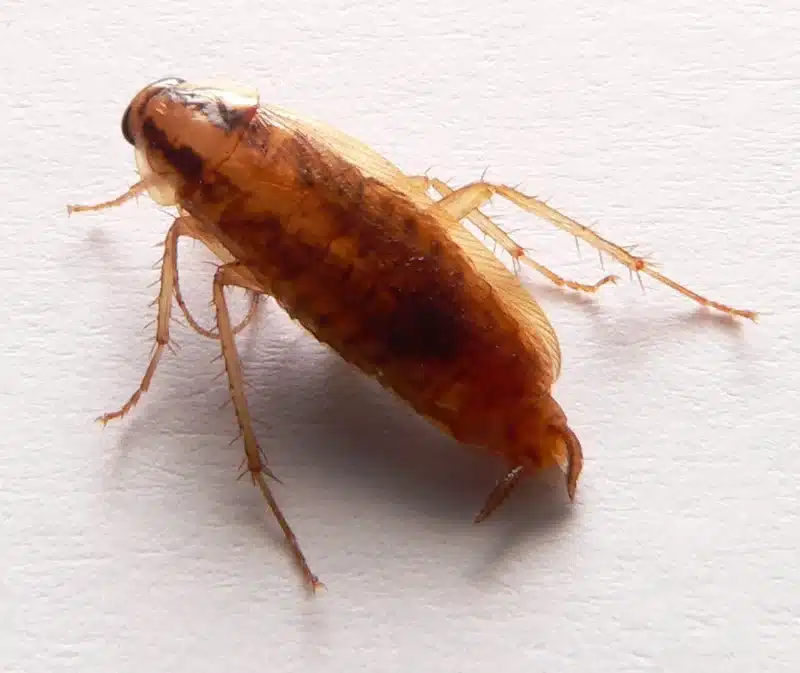Finding small, dark insects scurrying across your kitchen counter can be alarming. When you spot a baby German cockroach, you’re likely dealing with a growing infestation that requires immediate attention. These tiny nymphs signal that adult roaches have been reproducing in your home for weeks or months.
Understanding what baby German cockroaches look like and how to eliminate them effectively can mean the difference between a minor problem and a major infestation. After working in pest control for four years and helping thousands of customers in the DC metro area identify cockroach species, I’ve seen how quickly these populations can explode when left untreated.
What Is a Baby Cockroach? Baby German vs Baby American Cockroach Biology
A baby German cockroach is the nymph stage of Blattella germanica, the most common indoor cockroach species worldwide. These immature roaches go through several molting stages before becoming adults, spending most of their development time as wingless nymphs.
Unlike many other cockroach species, baby German cockroaches cannot survive outdoors in cold climates like Virginia, Maryland, and DC. They depend entirely on warm, humid indoor environments to complete their development. This indoor dependency makes them particularly problematic once they establish themselves in your home.
The lifecycle from egg to adult takes approximately 54 to 100 days under typical room temperatures of 75-85°F. Warmer conditions accelerate development, which explains why German roaches thrive near heat sources like water heaters and appliances.
What Baby Cockroaches Look Like: Identifying a Baby Roach
Baby German cockroaches have distinct characteristics that help differentiate them from other cockroach species and household insects. Proper identification ensures you choose the most effective treatment approach for your specific pest problem.
Size and Color of German Cockroach Nymphs
Baby German cockroaches range from 3 to 14 millimeters in length, depending on their developmental stage. The smallest first-instar nymphs appear almost black with pale edges along their sides.
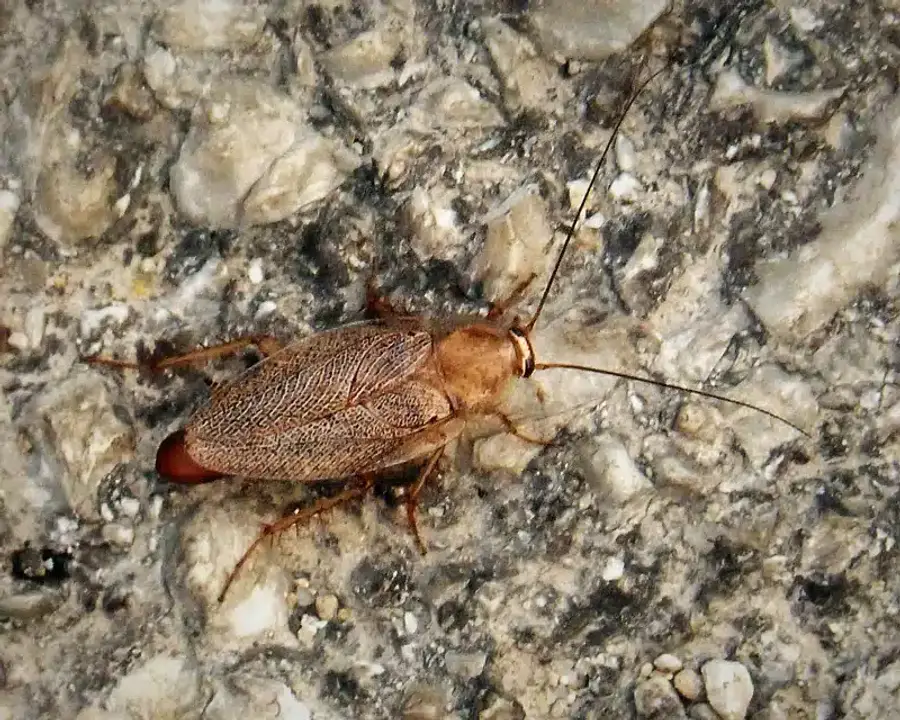
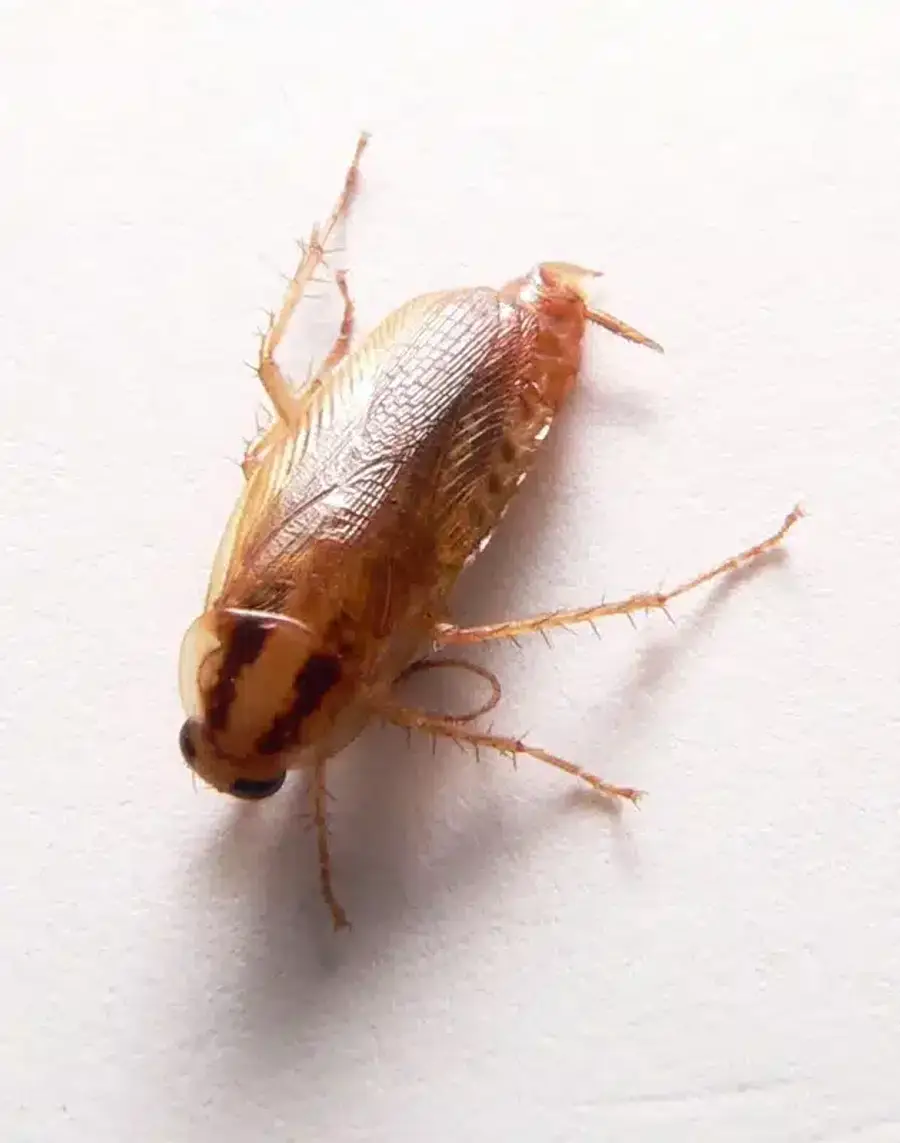

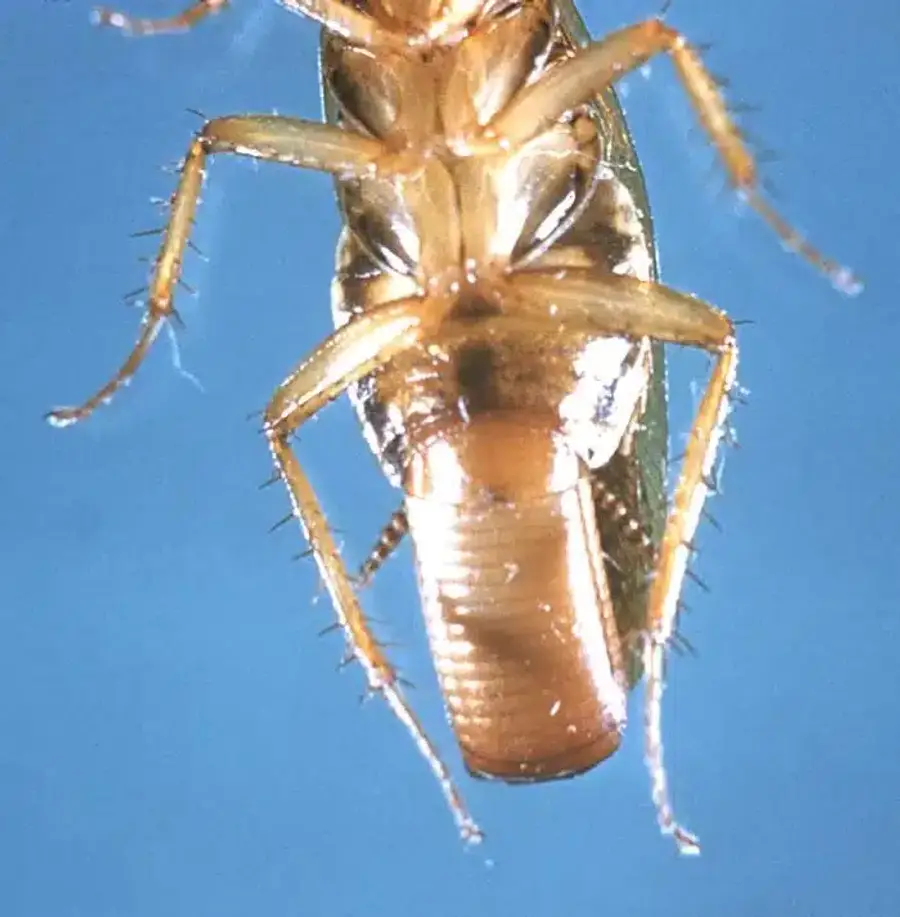
As they grow through successive molts, baby German cockroaches gradually lighten to brown or tan colors. The darker coloration of younger nymphs often confuses homeowners who expect them to look like miniature versions of the lighter-colored adults.
Two Racing Stripes: Pronotal Markings in Baby German Cockroach
The most reliable identifying feature of a baby German cockroach is the presence of two dark, parallel stripes running lengthwise down their back. These distinctive markings persist through all nymph stages and continue into adulthood.
These “racing stripes” distinguish baby German cockroaches from other small roach species like Oriental and American cockroach nymphs. Even when the body color changes during development, these stripes remain clearly visible.
Wing Buds and Instar Stages
Baby German cockroaches are completely wingless during their early development stages. As they progress through later instars, small wing pads become visible but remain non-functional until they reach adulthood.
According to NC State Extension research, populations typically consist of 80% nymphs and 20% adults. This ratio means you’re far more likely to encounter baby German cockroaches than fully developed adults during an active infestation.
Baby German Cockroach Life Cycle and Reproduction
Female German cockroaches carry their egg cases (oothecae) until just 1-2 days before hatching. Each yellowish-brown capsule contains approximately 40 developing baby German cockroaches, and a single female can produce 5-8 capsules during her lifetime.
The rapid reproduction rate creates exponential population growth under favorable conditions. Our family business has been serving the DMV area for over 50 years, and we’ve consistently observed that one fertile female and her offspring can theoretically produce over 30,000 roaches per year.
Temperature plays a crucial role in development speed. Baby German cockroaches develop faster in the warm, humid conditions commonly found behind refrigerators, under sinks, and inside dishwashers throughout the Washington metro area.
Habitat: Where to Find Baby German Cockroaches in Your Home
Baby German cockroaches prefer tight spaces that provide warmth, humidity, and proximity to food sources. They exhibit thigmotactic behavior, meaning they seek environments where their bodies can touch multiple surfaces simultaneously.
Common hiding spots include:
- Behind and under kitchen appliances
- Inside cabinet hinges and drawer slides
- Around plumbing fixtures in bathrooms
- Near water heaters and HVAC units
- Behind outlet covers and switch plates
These nymphs rarely venture far from their harborage areas during daylight hours. However, severe infestations may force baby German cockroaches into more visible areas as competition for prime hiding spots increases.
Signs You Have a Baby German Cockroach Infestation
Key Infestation Indicators
Early detection of baby German cockroach activity allows for more effective treatment outcomes. Look for small, dark droppings that resemble ground black pepper in cabinet corners and along baseboards.
Cast skins from molting nymphs often accumulate in harborage areas. These translucent shells retain the characteristic two-stripe pattern and indicate active baby German cockroach development in your home.
Live sightings during daylight hours suggest a well-established population. Baby German cockroaches typically remain hidden during the day unless overcrowding forces them into the open. Additionally, you might notice a musty odor in heavily infested areas where large numbers of nymphs congregate.
Health and Economic Risks of Baby German Cockroaches
Baby German cockroaches pose significant health concerns, particularly for households with asthma sufferers. Their shed skins, feces, and saliva contain allergens that trigger respiratory symptoms, especially in children living in urban environments.
These pests can mechanically transport bacteria like Salmonella and Staphylococcus on their bodies as they move between contaminated areas and food preparation surfaces. The risk becomes particularly concerning in commercial kitchens and medical facilities.
From an economic perspective, baby German cockroach infestations can damage your home’s value and reputation. Real estate transactions often require pest inspections, and active cockroach problems can delay closings or reduce sale prices significantly.
How to Get Rid of Baby Cockroaches: DIY Treatment for Baby Brown-banded Cockroaches
Homeowners can address small baby German cockroach infestations using integrated management approaches that combine sanitation, exclusion, and targeted treatments. Success depends on thoroughness and persistence rather than relying solely on chemical solutions.
Sanitation Steps to Disrupt Nymph Habitats
Remove all food sources that sustain baby German cockroach populations. Store dry goods in sealed containers and eliminate crumb accumulations behind appliances and inside drawers.
Fix water leaks and reduce humidity around plumbing fixtures where baby German cockroaches thrive. Use dehumidifiers in basements and crawl spaces to create less favorable development conditions. Additionally, remove clutter that provides additional harborage opportunities for growing nymph populations.
Using Gel Baits and IGRs on Baby German Cockroach
Professional-grade gel baits containing indoxacarb or clothianidin effectively target baby German cockroaches when applied correctly. Place pea-sized bait spots every 8-12 inches in harborage areas where nymphs congregate.
Insect Growth Regulators (IGRs) disrupt baby German cockroach development by preventing successful molting. Products containing hydroprene or pyriproxyfen provide 3-6 months of population suppression when combined with baiting programs.
For more detailed information about treatment options, check out our guide on boric acid for roaches and alternative approaches.
Applying Boric Acid and Desiccant Dusts
Boric acid and diatomaceous earth work as desiccant dusts that dehydrate baby German cockroaches upon contact. Apply light dustings in wall voids, behind kick plates, and other protected areas where nymphs travel.
Avoid heavy applications that create visible dust piles, which roaches will simply avoid. The key to success lies in creating thin, invisible barriers that baby German cockroaches cannot detect but must crawl through to reach food and water sources.
Professional Treatment Options for Baby German Cockroach Infestations
Licensed technicians have access to commercial-grade products and application techniques that provide faster, more comprehensive baby German cockroach elimination. Professional treatment becomes essential for moderate to heavy infestations or when DIY efforts fail to achieve adequate control.
Inspection and Monitoring by Licensed Technicians
Our registered technicians begin with detailed inspections to identify all baby German cockroach harborage areas and assess population levels. We use sticky traps strategically placed near suspected activity zones to quantify infestation severity.
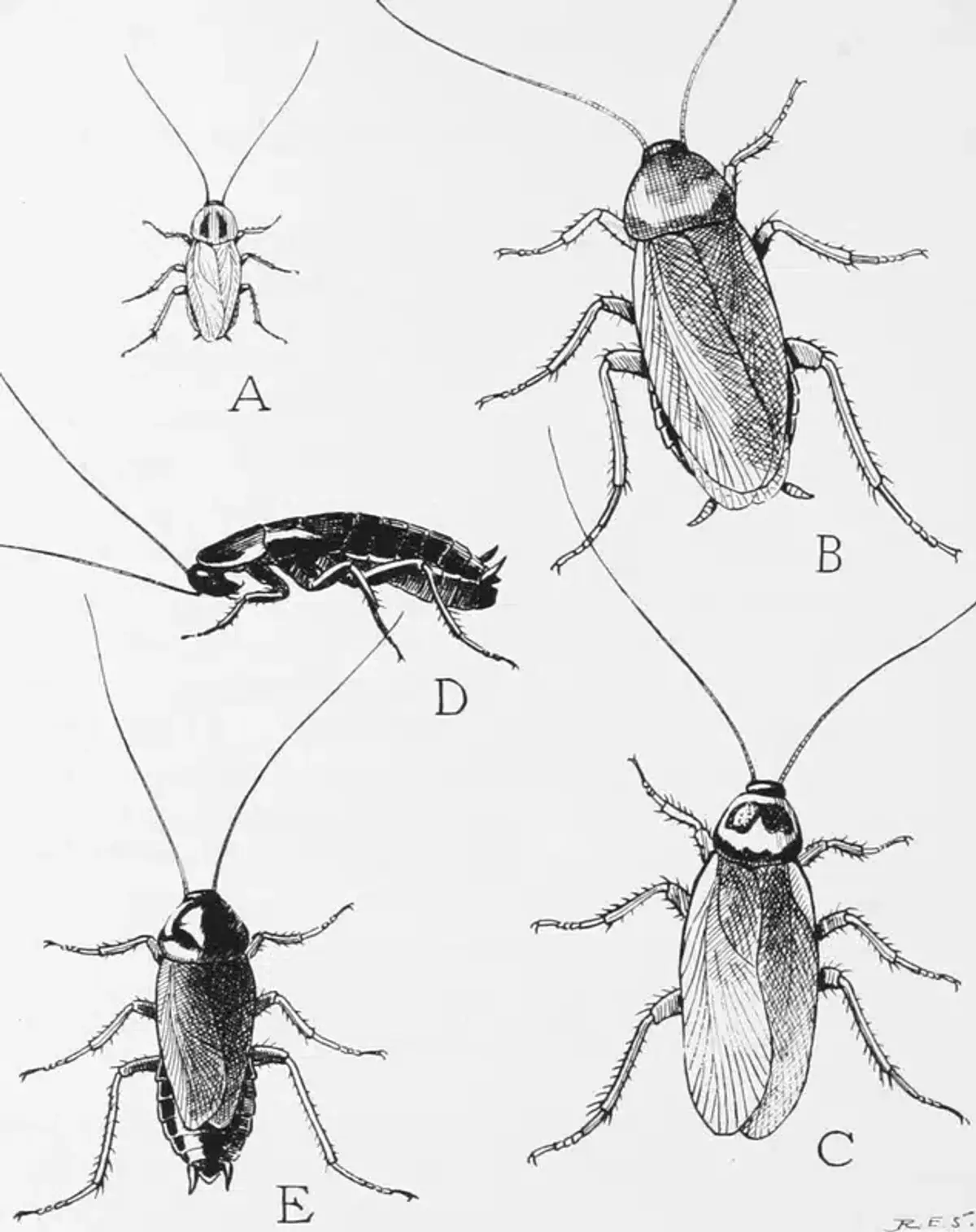
During inspections, we interview customers about sanitation practices and moisture issues that contribute to baby German cockroach survival. This information helps us develop customized treatment plans that address the specific conditions supporting your infestation.
Based on our 4 years of experience treating cockroach problems throughout the DMV area, proper identification and thorough inspection form the foundation of successful baby German cockroach elimination programs.
Crack-and-Crevice Non-Repellent Treatments
Professional applications focus on crack-and-crevice treatments using non-repellent insecticides that baby German cockroaches cannot detect or avoid. We apply materials like chlorfenapyr and indoxacarb directly into harborage areas where nymphs develop.
Our technicians may remove outlet covers and treat behind electrical fixtures when necessary. These hidden areas often harbor significant baby German cockroach populations that remain inaccessible to surface treatments and DIY efforts.
We avoid using repellent pyrethroids near bait placements, as these materials can interfere with feeding behavior and reduce treatment effectiveness against baby German cockroach populations.
Follow-Up Visits & Resistance Management
Professional baby German cockroach treatment typically requires multiple visits spaced 2-3 weeks apart to address newly hatched nymphs. Resistance to multiple insecticide classes has been documented, making rotation between different active ingredients crucial for long-term success.
We monitor treatment progress using sticky traps and adjust our approach based on population response. If baby German cockroach numbers don’t decline significantly within 14 days, we switch to alternative chemistry classes to overcome potential resistance issues.
Our follow-up visits also include sanitation coaching and exclusion recommendations that help prevent future baby German cockroach infestations in your home.
Cost to Remove Baby German Cockroach: DIY vs Professional
DIY baby German cockroach treatment costs typically range from $40-80 for bait gels, IGRs, and monitoring traps. However, success depends heavily on proper identification, thorough application, and consistent follow-through over several months.
Professional baby German cockroach removal costs vary based on infestation severity and home size:
- Small apartment treatments: $100-250 for initial service
- Standard homes (1,500-2,000 sq ft): $250-350 initial plus $75-100 follow-up visits
- Severe infestations requiring multiple visits: $2,500-7,000+
For detailed pricing information, visit our comprehensive exterminator cost guide and pest control pricing overview.
Professional vs DIY: Choosing the Right Path for Baby German Cockroach Control
Small baby German cockroach infestations with fewer than 20 insects per sticky trap per week can often be managed successfully by experienced homeowners using sanitation improvements and gel bait applications.
When Professional Treatment is Necessary
Professional treatment becomes necessary when:
- Baby German cockroach populations exceed 20 per trap weekly
- Multiple rooms show signs of activity
- Previous DIY efforts have failed after 6-8 weeks
- You live in multi-unit housing where reinfestation is likely
For comparison with other cockroach species, check our guides on American roaches and Oriental roaches to ensure you’re targeting the correct pest.
Tips from Four Years of Cockroach Control Experience
Baby Cockroaches vs Bed Bug: Brown-banded Cockroach and Other Related Pests
Baby German cockroaches are often confused with other small insects and cockroach nymphs. For comprehensive identification help, review our small roaches identification guide and big roach identification article.
Oriental roaches produce darker, more oval-shaped nymphs that typically inhabit basements and crawl spaces rather than kitchens. American roaches develop much larger nymphs that prefer commercial buildings and sewer systems.
Some customers mistake baby German cockroaches for beetles or other insects. When in doubt, look for the characteristic two racing stripes and wingless appearance that distinguish these nymphs from similar-sized household pests.
Preventing Future Baby German Cockroach Infestations
Prevention focuses on eliminating the conditions that support baby German cockroach development. Seal cracks around plumbing penetrations with silicone caulk to eliminate entry points from adjacent units or outdoor areas.
Install door sweeps and weather stripping to reduce harborage opportunities. Store food in insect-proof containers and clean up spills immediately to remove attractants that draw roaches into your living spaces.
Consider our SeasonGuard+ program, which includes tri-annual treatments (three times per year) targeting baby German cockroaches alongside 34 other common pests. This comprehensive approach provides year-round protection against reinfestation while addressing seasonal pest pressures throughout the DMV area.
Next Steps for Baby German Cockroach Control
Successfully eliminating baby German cockroaches requires combining proper identification, targeted treatments, and ongoing prevention strategies tailored to your specific situation. Whether you choose DIY methods or professional treatment depends on the infestation severity and your comfort level with pest control products.
Remember that baby German cockroach problems indicate active breeding populations that will continue growing without intervention. Early action prevents small problems from becoming major infestations that require extensive treatment programs.
If you’re dealing with baby German cockroach activity in the Virginia, Maryland, or DC area, our registered technicians can provide expert identification and customized treatment recommendations. Call us at 703-683-2000 or email info@bettertermite.com for a consultation and detailed treatment estimate.
Frequently Asked Questions About Baby German Cockroach Removal
How long does it take to eliminate baby German cockroach nymphs?
+
Complete baby German cockroach elimination typically takes 8-12 weeks with proper treatment and sanitation. The timeline depends on infestation severity, environmental conditions, and treatment consistency. New nymphs continue hatching from existing egg cases for several weeks after initial treatment begins.
Will DIY baits kill all baby German cockroaches?
+
DIY gel baits can effectively control small baby German cockroach populations when applied correctly and combined with thorough sanitation. However, bait success depends on eliminating competing food sources and placing treatments in areas where nymphs actively forage. Severe infestations often require professional treatment with commercial-grade products.
How much does professional pest control cost for baby German cockroaches in the DMV?
+
Professional baby German cockroach treatment in Virginia, Maryland, and DC typically costs $100-250 for apartments and $250-350 for standard homes. Severe infestations requiring multiple visits and specialized treatments can cost $2,500-7,000. Follow-up visits generally range from $75-100 per service.
Can baby German cockroaches survive without food for extended periods?
+
Baby German cockroaches can survive approximately 2-4 weeks without food, depending on their developmental stage and environmental conditions. However, they require water every few days to survive. This survival ability allows populations to persist during brief sanitation improvements, requiring sustained treatment efforts.
Do I need to clear cabinets before professional baby German cockroach treatment?
+
Yes, clearing cabinets and moving items away from walls allows technicians to access harborage areas where baby German cockroaches congregate. This preparation ensures thorough crack-and-crevice treatments reach hidden populations behind appliances and inside cabinet spaces. Proper preparation significantly improves treatment effectiveness.
Are baby German cockroaches more difficult to eliminate than adults?
+
Baby German cockroaches can be more challenging to eliminate because they spend more time in protected harborage areas and have higher metabolic rates. Additionally, they continue hatching from egg cases over several weeks, requiring sustained treatment efforts. Professional treatments often target nymph development specifically using IGRs and targeted baiting programs.
What's the difference between baby German cockroaches and other small roaches?
+
Baby German cockroaches display distinctive two dark stripes running lengthwise down their backs through all developmental stages. They remain smaller and darker than other cockroach nymphs and prefer kitchen and bathroom environments. Other species like Oriental and American cockroach nymphs grow larger and typically inhabit basements or outdoor areas.
With five years of hands-on experience in the pest control industry, George Schulz is a registered technician with the Virginia Pest Management Association and a proud third-generation professional in a family business that's been protecting homes for over 57 years. He manages and trains a team of service pros while also leading internal research efforts—recently spearheading a deep-dive review of thousands of documents on pest control materials to hand-pick the most kid and pet friendly, most effective solutions tailored specifically for homes in the DC metro area.
